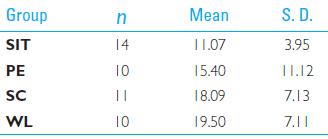How do the results of Exercise 16.9 compare with the results you obtained in Exercise 16.7? (They
Question:
How do the results of Exercise 16.9 compare with the results you obtained in Exercise 16.7?
(They should agree, but not too closely.)
Exercise 16.7
Foa, Rothbaum, Riggs, and Murdock (1991) conducted a study evaluating four different types of therapy for rape victims. The Stress Inoculation Therapy (SIT) group received instructions on coping with stress. The Prolonged Exposure (PE) group went over the events in their minds repeatedly. Those in the Supportive Counseling (SC) group were taught a general problemsolving technique. Finally, the Waiting List (WL) control group received no therapy. Data with the same characteristics as theirs follow, where the dependent variable was the severity rating of a series of symptoms.
a) Run the analysis of variance, ignoring any problems with heterogeneity of variance, and draw whatever conclusions are warranted. (Note that you have to be a little creative here, but it is not a difficult exercise.)
b) Draw a graph showing the means of the four groups.
c) What does rejection of the null hypothesis mean?
Exercise 16.9
Use the R code on this chapter’s Web page to generate data that could lie behind exercise 16.7 and then run the analysis of variance.
Step by Step Answer:

Fundamental Statistics For The Behavioral Sciences
ISBN: 9781305652972
9th Edition
Authors: David C. Howell




